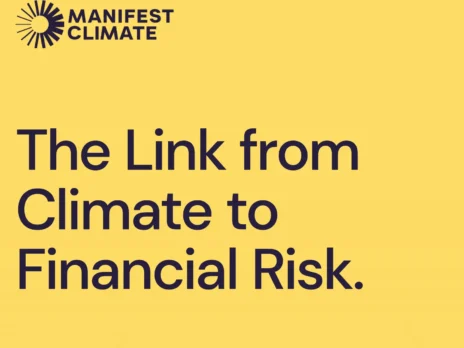

Climate disclosures and benchmarking are becoming increasingly significant requirements for companies of all sizes. Doing so requires the collection and analysis of great swathes of structured and unstructured data to build a contextual landscape, gauge exposures, reveal opportunities, build competency, and devise and execute climate strategy.
However, for all but the largest organisations, securing the requisite data and climate talent can be a significant challenge, with much of the collation and analysis work still performed manually. Increasingly, artificial intelligence (AI) and machine learning (ML) are being used to collate and process data, reveal blind spots and data gaps, and surface decision-useful information. Such automation can significantly accelerate organisations’ access to climate learning and provide a competitive advantage.
Manifest Climate is committed to leveraging this potential. Using advanced ML in coordination with climate experts, Manifest Climate’s AI-enabled assessment models can evaluate how well an organisation’s climate-related disclosures align with different disclosure frameworks and standards — both in broad terms and to assess decision-usefulness. Based on these assessments, manually verified by those experts, Manifest Climate can recommend specific actions that clients can take to improve their overall climate response.
The company’s data science manager Ahmad Ghazi has only been in the climate field for less than a year. While impressed by the extent to which he sees the use of AI in the climate space, he believes it is generally not underpinned by the type of genuine, human climate expertise employed by Manifest Climate.
“To get the modelling and outcomes required, you need the climate flavour that experts bring,” says Ghazi. “Part of me wanting to get involved was to learn from and access that expertise. The expertise is the difference.”
Managing climate data complexity with AI
Manifest Climate’s vision is to scale access to corporate climate resilience and competence by combining the best of both worlds. In climate risk planning, collation and analysis of unstructured data still rely heavily on human intervention. Manifest Climate uses natural language processing (NLP) to pull from a diverse range of sources – such as company reports, conference calls, PDFs, and websites. The company has developed a methodology that encompasses approximately 200 data points, manually labelling data in order to create machine learning algorithms that can then qualify, structure and present from a wide variety of sources.
Climate expertise drives the process and AI capabilities support it, rather than vice-versa. “Having been rooted in the TCFD and other standards for years, we have the expertise to justify the decisions we’ve made on how to structure this data,” says Manifest Climate product content director Louie Woodall.
AI models become better the more data they have to crunch – and the more experts have trained them in what “good” looks like. Across those 200 or so points, quality data is easier to come by for some than others. “Getting more examples and assessing disclosures for data points is where we need the human touch,” says Ghazi. “There are the basics, emissions or net zero targets, for example, which are more structured, but others are not as widely disclosed or clear,” says Ghazi.
“Certain climate disclosures do not have standardised definitions right now,” adds Woodall. “There’s a fuzziness around certain concepts, such as what makes for a ‘well-defined process’ for climate risk management integration. ‘Well-defined’ is a subjective term, so trying to assess whether or not a disclosure contains this information using NLP, ML and AI is a challenge.”
Translating data to drive strategies
That’s where climate expertise plays a vital role, manually labelling climate disclosures so that, over time, assessment and qualification can become ever more automated. One must also remember that, with this space still in its relative infancy, organisations still early along in their journeys may still desire guidance that comes with human features, rather than a digital interface.
“We have an extensive dataset, and we expect more automation in data production, but we still need our consultants and climate expertise to translate that data into a story that makes sense to clients,” says Woodall. “Clients want the human touch to explain the meaning behind it, they want to know how to improve their climate management and strategy.”
Manifest Climate’s comprehensive climate assessment methodology enables companies to gauge alignment across multiple global frameworks and standards, such as the Task Force on Climate-related Financial Disclosures (TCFD), the US Securities and Exchange Commission’s (SEC) forthcoming climate disclosure rule and the International Sustainability Standards Board’s (ISSB) imminent climate reporting standards. It shows opportunities for improvement or where there are risks using gap analysis. It also benchmarks companies’ climate progress against industry peers and climate leaders.
“Mapping out disclosures for internationally active companies to multiple standards and identifying data that is relevant across all standards is incredibly useful,” says Woodall. “We can structure data in a way that works across all climate disclosure frameworks.”
One example of the significance of being able to gauge alignment across various frameworks comes amid the suggestion that non-EU companies could soon be subject to EU sustainability rules under the Corporate Sustainability Reporting Directive.
Demand for data
Such developments are indicative of the fact that climate reporting is constantly evolving, something Manifest Climate also builds into its models. “There are new insights and best practices that we surface from our data set to feed our methodology,” says Ghazi. “It gives us more data points to use as levers when we are analysing a company. It can be a struggle, but it is also exciting.”
There will always be a need for human experts. However, only through leveraging AI and ML to scale knowledge and insight can all organisations enjoy access to the climate expertise required for successfully navigating this journey.
“I don’t think anyone assesses companies to the level of detail that we do, that allows us to come up with decision points, gap analysis, recommendations because no one has that data,” says Ghazi. “For me, that is our difference maker.”







